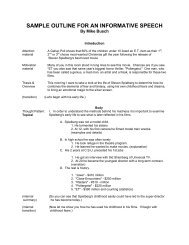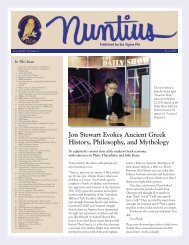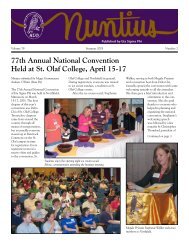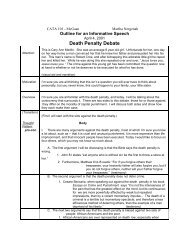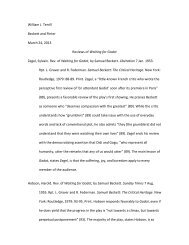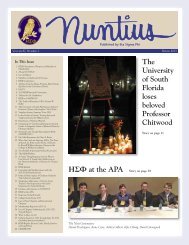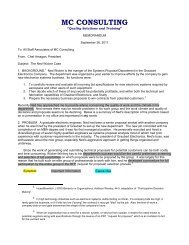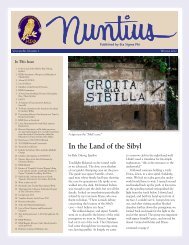Vol. 82, No. 2, Summer 2008 - Monmouth College
Vol. 82, No. 2, Summer 2008 - Monmouth College
Vol. 82, No. 2, Summer 2008 - Monmouth College
Create successful ePaper yourself
Turn your PDF publications into a flip-book with our unique Google optimized e-Paper software.
onzing a log which fell from heavenwith “the thunderbolt hurled [by Zeus]at the bridal chamber of Semele” (Pausanias.Description of Greece, <strong>Vol</strong>. 4. Trans.Jones, W.H.S. Cambridge, Mass.: HarvardUniversity Pres, 1978. 9.12.4). Labdacus’offenses against Bacchus, however, earnedhim the same fate as his cousin Pentheuswith whom, Apollodorus tells us, “he waslike-minded,” implying that he too resistedthe worship of Dionysus (Apollodorus.The Library. <strong>Vol</strong>. 1. Trans. Frazer, Sir JamesGeorge. Cambridge, Mass.: Harvard UniversityPress, 1976. 3.3.8). This recurringsin of impiety finds its origin in Cadmushimself, whose crime is referenced, thoughsomewhat obscurely, by Sophocles in hisremark on the river Ismenus (Antigone,1124). Here the poet alludes to the foundingmyth of Thebes in which Cadmus,“being angered,” slew the serpent whichguarded the river, a creature dear to Ares,and was, along with his wife, “turned intoa serpent.” Apollodorus tells likewise howCadmus, thus earning the disfavor of thegod, was sentenced to an “eternal year” ofcompensatory labor (Apollodorus, 3.4.1).The historian later adds that their punishmentwas compounded by their serpentinetransformation (Apollodorus, 3.5.4). It isnotable too that this river is named for oneof the fallen children of Niobe, to be discussedlater on in this paper, whereas theDircean, another local stream, is namedfor Dirce, the wife of Lycus, killed byAmphion and Zethus who tied her to thehorns of a bull, a punishment for mistreatingtheir mother.The third choral ode again takes upthis legacy of irreverence which, begun byCadmus, was carried on by his son Pentheusand grandson Labdacus. Ino’s sons,Learchus and Melicertes, meet a similarfate and are murdered by their parentswho, entrusted by Hermes with the care ofthe infant Dionysus, are driven mad by theever jealous and vengeful Hera. Athamas,Ino’s husband, hunted Learchus “as adeer” and slew him with an arrow. Ino,likewise, threw Melicertes into a boilingpot (Apollodorus, 3.4.3). Homer relateshow Ino, in her grief, threw herself into theocean and became the sea-deity Leucothea(Odyssey, V.332ff). The other daughtersof Cadmus met similar ends which wouldensure that the narrowing and eventualend of their family line. Semele destroyedherself when she looked upon the bare faceof Zeus. Agave, having killed her son, fledThebes, and, after being taken in by Lycotherses,murdered him so that Cadmusmight rule Illyria, presumably not havingany children by him to ensure Cadmus’claim (cf. Hyginus, 184 and 240. TheMyths of Hyginus. Trans. Grant, Mary. Lawrence:University of Kansas Press, 1960).Similarly, it can be presumed by the factthat no other offspring of hers are mentionedin extant literature that Autonöe isbeyond child-bearing age after the death ofActaeon, though her husband Aristaeus isknown to have fathered three other children;a daughter Macris, also called Nysa,a nymph and a caretaker of Dionysus,and two sons Charmus and Callicarpus(Apollonius. Argonautica IV.1128, <strong>No</strong>nnus,Dionysiaca 84.<strong>82</strong>.4). Dionysus’ powerfulinfluence over Cadmian Thebes is furthercompounded when Semele, brought backfrom the underworld by her son, is addedto the host of Olympus as Thyone, thegoddess of inspired frenzy. Actaeon, theson of Autonöe, also is slain with similardivine impunity, though not by Dionysus.Apollodorus relates how he was turnedinto a stag and eaten by his hunting dogs,for lusting after either Semele or Artemis(Apollodorus 3.4.4).Having thus drawn through inference arough sketch of what contemporary audienceswould have implicitly known aboutthe relation between Thebes’ patron deityand the House of Cadmus, it is proper,before considering the main action ofthe play itself, to work out what explicitallusions Sophocles makes to the greaterstory-arc of the Theban cycle. Sophocles,along with many others, speaks of Antigone’sdescent from both sets of Thebes’alleged founders: that is, not only, Cadmusand Harmonia, but also Amphion andZethus, to whom the building of the citywallswas attributed. Herodotus tells us inhis History that he has seen an inscriptionthat “would date from about the time ofLaius the son of Labdacus, grandson ofPolydorus and great-grandson of Cadmus”(Herodotus, 5.59.1. Trans. Godley, A.D.Herodotus. <strong>Vol</strong>. 2. Cambridge, Mass.:Harvard University Press, 1969-1975).Sophocles completes Antigone’s paternal(and also, tragically, maternal) lineageby telling us that Oedipus is the son ofLaius and the father of Antigone. Thelater historian Apollodorus ties thesetwo founding lineages together by tellingthe of tale of the marriage of Polydorus,Oedipus’ great-grandfather, to Nycteis,sister to Antiope, the mother of Amphionand Zethus (Apollodorus, 3.5.5). It islikely that during the time of Sophoclesthis integration of the two foundingmyths was already established and addedto the mythological emphasis placed onthe Labdacids by the poet. For a sense ofhow Apollodorus historically justified theconflicting accounts of the foundation ofThebes, compare the ambiguity inherentin the accounts of Cadmus and the Spartoiand Amphion and Zethus (Apollodorus3.4.1. and 3.5.6) to the surety with whichHomer propounds the truth of the latterstory (Odyssey, XI.260ff). After the deathof Labdacus, Lycus, ward to Laius andbrother to Polydorus’ father-in-law, tookthe throne of Thebes for twenty years, atwhich time he was usurped by Amphionand Zethus (Apollodorus, 3.5.5). Theirrule, however, was just as short-lived, andboth their lines were extinguished by thefoolishness of their wives. Niobe, the wifeof Amphion, who is twice mentioned inthe Antigone, boasted that she had morechildren than Leto. In turn the goddess’children, Artemis and Apollo, struck downher family, leaving Niobe alone to bewailthem (Apollodorus, 3.5.7). Similarly,Homer tells the story of how the death ofItylus, the sole heir of Zethus, at the handsof his careless mother, persuades Penelopeto endure the plague of the suitors ratherthan return to her father (Odyssey,XIX.523). Pausanias adds too that Zethus,upon hearing the news of his son’s death,died of a “broken heart” (Pausanias, 9.5.9).It is in the marriage of Polydorus andNycteis that the lineage of Cadmus, thefirst founder of the Thebes, intersectswith the lineage of Amphion and Zethus,the builders of its wall. The fruit of thismarriage is Laius who, during the strugglebetween Lycus and the sons of Antiope,lives as an exile in the kingdom of Pelops.Returning from this exile to Thebes,Laius brings with him Chrysippus, the19



